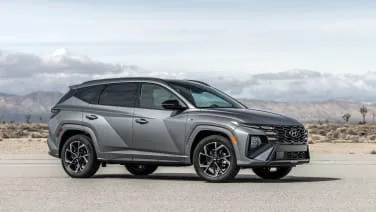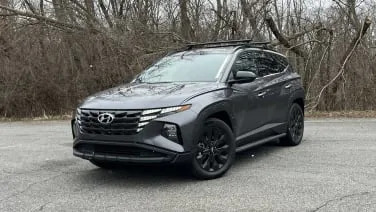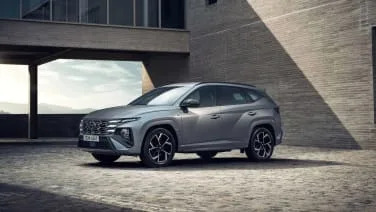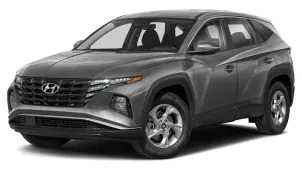2024 Hyundai Tucson
Industry
Pros: All-star hybrid powertrain; excellent tech; huge cargo area; strong safety credentials; high-quality cabin Cons: Uninspiring base engine; some weird interior controls; a bit blah to drive The 2024 Hyundai Tucson has all the makings of a sensible, uber-practical compact SUV choice. It’s really big, with one of the most voluminous cargo areas around. It gets good fuel economy, including the surprisingly powerful and very-much-recommended Tucson Hybrid. The interior is well put together and features user-friendly technology. The safety credentials are top notch in terms of equipment and crash ratings. Add it all up and you have a very sound choice. Thing is, words like “sensible” and “uber-practical” are usually attached to bland, anonymous SUVs that practically disappear in a parking lot. People almost expect them to be boring. “Oh yeah? Watch this!” That’s what we imagine Hyundai designers saying as they went about putting together the explosion of creases, odd bulges and kitchen-sink details that is the Tucson. The smiling grille lights up on its edges like a Vegas marquee; the wheel arches are angular rather than actual arches; there are diamond shapes in the rear bumper; the LED taillights drop down into the liftgate like quadruple Dracula fangs. It’s a lot. Maybe too much, so if you like all of the above sensible stuff but would rather a different look, consider the mechanically related Kia Sportage. We also recommend the Honda CR-V, Toyota RAV4 and Mazda CX-50. Not that any of the above are that boring any more, but none make quite the statement of the 2024 Tucson. Interior & Technology | Passenger & Cargo Space | Performance & Fuel Economy What it's like to drive | Pricing & Trim Levels | Crash Ratings & Safety Features What's new for 2024? The Tucson gets an infusion of safety equipment for 2024. Rear seat side airbags, rear outboard seatbelt pre-tensioners, seatbelt reminders for all seats, and haptic steering wheel feedback for the lane-keeping and blind-spot warning systems are not only now available, but standard. There are other feature enhancements as well. The 10.25-inch touchscreen is now added to more trim levels, including the SEL Convenience and all hybrids; dual-zone climate control is now standard on all but the base trim; and the ambient lighting color selection goes from 10 to 64. The N-Line trim level is also now powered by the hybrid, which is a good thing. What are the Tucson interior and in-car technology like? The Tucson’s cabin is stylish, tech-focused and premium in terms of both appearance and quality. We especially like the dash-width vents and cloth trim. There are some key differences based on trim level, however. Besides upholstery and color choices, the center stack controls actually differ. The SE and SEL come with an 8-inch touchscreen, while an upgrade 10.25-inch widescreen unit is standard on everything else. Their basic user interface is similar, but the bigger screen increases functionality. Frustratingly, only the 8-inch screen is compatible with wireless Android Auto and Apple CarPlay; the larger …
Full Review
Pros: All-star hybrid powertrain; excellent tech; huge cargo area; strong safety credentials; high-quality cabin Cons: Uninspiring base engine; some weird interior controls; a bit blah to drive The 2024 Hyundai Tucson has all the makings of a sensible, uber-practical compact SUV choice. It’s really big, with one of the most voluminous cargo areas around. It gets good fuel economy, including the surprisingly powerful and very-much-recommended Tucson Hybrid. The interior is well put together and features user-friendly technology. The safety credentials are top notch in terms of equipment and crash ratings. Add it all up and you have a very sound choice. Thing is, words like “sensible” and “uber-practical” are usually attached to bland, anonymous SUVs that practically disappear in a parking lot. People almost expect them to be boring. “Oh yeah? Watch this!” That’s what we imagine Hyundai designers saying as they went about putting together the explosion of creases, odd bulges and kitchen-sink details that is the Tucson. The smiling grille lights up on its edges like a Vegas marquee; the wheel arches are angular rather than actual arches; there are diamond shapes in the rear bumper; the LED taillights drop down into the liftgate like quadruple Dracula fangs. It’s a lot. Maybe too much, so if you like all of the above sensible stuff but would rather a different look, consider the mechanically related Kia Sportage. We also recommend the Honda CR-V, Toyota RAV4 and Mazda CX-50. Not that any of the above are that boring any more, but none make quite the statement of the 2024 Tucson. Interior & Technology | Passenger & Cargo Space | Performance & Fuel Economy What it's like to drive | Pricing & Trim Levels | Crash Ratings & Safety Features What's new for 2024? The Tucson gets an infusion of safety equipment for 2024. Rear seat side airbags, rear outboard seatbelt pre-tensioners, seatbelt reminders for all seats, and haptic steering wheel feedback for the lane-keeping and blind-spot warning systems are not only now available, but standard. There are other feature enhancements as well. The 10.25-inch touchscreen is now added to more trim levels, including the SEL Convenience and all hybrids; dual-zone climate control is now standard on all but the base trim; and the ambient lighting color selection goes from 10 to 64. The N-Line trim level is also now powered by the hybrid, which is a good thing. What are the Tucson interior and in-car technology like? The Tucson’s cabin is stylish, tech-focused and premium in terms of both appearance and quality. We especially like the dash-width vents and cloth trim. There are some key differences based on trim level, however. Besides upholstery and color choices, the center stack controls actually differ. The SE and SEL come with an 8-inch touchscreen, while an upgrade 10.25-inch widescreen unit is standard on everything else. Their basic user interface is similar, but the bigger screen increases functionality. Frustratingly, only the 8-inch screen is compatible with wireless Android Auto and Apple CarPlay; the larger …
Hide Full Review
Hide Full Review
Retail Price
$27,500 - $38,260
MSRP / Window Sticker Price
| Engine | 2.5L I-4 |
| MPG | Up to 25 city / 32 highway |
| Seating | 5 Passengers |
| Transmission | 8-spd w/OD |
| Power | 187 @ 6100 rpm |
| Drivetrain | HTRAC all wheel, front-wheel |
| Curb Weight | 3,346 - 3,690 lbs |
Smart Buy Program is powered by 







